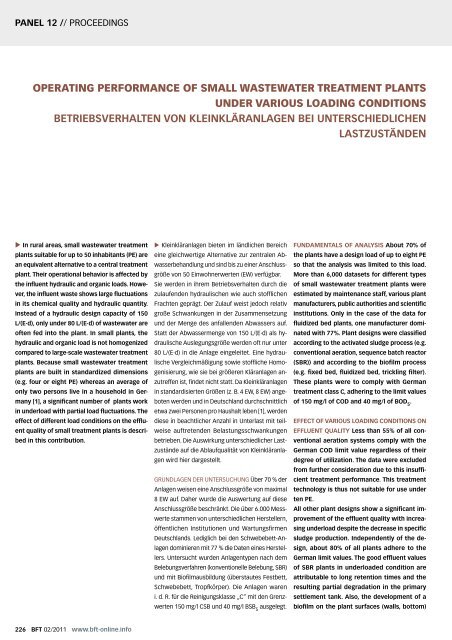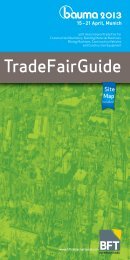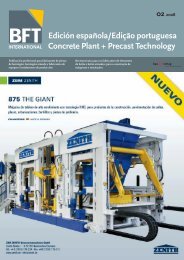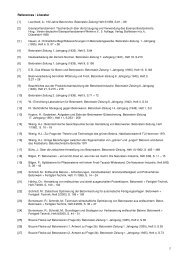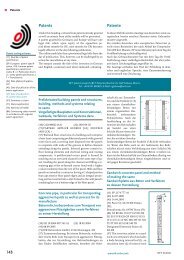Tagungsband - BFT International
Tagungsband - BFT International
Tagungsband - BFT International
Erfolgreiche ePaper selbst erstellen
Machen Sie aus Ihren PDF Publikationen ein blätterbares Flipbook mit unserer einzigartigen Google optimierten e-Paper Software.
PANEL 12 // PROCEEDINGS<br />
OPERATING PERFORMANCE OF SMALL WASTEWATER TREATMENT PLANTS<br />
UNDER VARIOUS LOADING CONDITIONS<br />
BETRIEBSVERHALTEN VON KLEINKLÄRANLAGEN BEI UNTERSCHIEDLICHEN<br />
LASTZUSTÄNDEN<br />
� In rural areas, small wastewater treatment<br />
plants suitable for up to 50 inhabitants (PE) are<br />
an equivalent alternative to a central treatment<br />
plant. Their operational behavior is affected by<br />
the influent hydraulic and organic loads. Howe-<br />
ver, the influent waste shows large fluctuations<br />
in its chemical quality and hydraulic quantity.<br />
Instead of a hydraulic design capacity of 150<br />
L/(E∙d), only under 80 L/(E∙d) of wastewater are<br />
often fed into the plant. In small plants, the<br />
hydraulic and organic load is not homogenized<br />
compared to large-scale wastewater treatment<br />
plants. Because small wastewater treatment<br />
plants are built in standardized dimensions<br />
(e.g. four or eight PE) whereas an average of<br />
only two persons live in a household in Ger-<br />
many [1], a significant number of plants work<br />
in underload with partial load fluctuations. The<br />
effect of different load conditions on the efflu-<br />
ent quality of small treatment plants is descri-<br />
bed in this contribution.<br />
226 <strong>BFT</strong> 02/2011 www.bft-online.info<br />
� Kleinkläranlagen bieten im ländlichen Bereich<br />
eine gleichwertige Alternative zur zentralen Ab-<br />
wasserbehandlung und sind bis zu einer Anschluss-<br />
größe von 50 Einwohnerwerten (EW) verfügbar.<br />
Sie werden in ihrem Betriebsverhalten durch die<br />
zulaufenden hydraulischen wie auch stofflichen<br />
Frachten geprägt. Der Zulauf weist jedoch relativ<br />
große Schwankungen in der Zusammensetzung<br />
und der Menge des anfallenden Abwassers auf.<br />
Statt der Abwassermenge von 150 L/(E∙d) als hy-<br />
draulische Auslegungsgröße werden oft nur unter<br />
80 L/(E∙d) in die Anlage eingeleitet. Eine hydrau-<br />
lische Vergleichmäßigung sowie stoffliche Homo-<br />
genisierung, wie sie bei größeren Kläranlagen an-<br />
zutreffen ist, findet nicht statt. Da Kleinkläranlagen<br />
in standardisierten Größen (z. B. 4 EW, 8 EW) ange-<br />
boten werden und in Deutschland durchschnittlich<br />
etwa zwei Personen pro Haushalt leben [1], werden<br />
diese in beachtlicher Anzahl in Unterlast mit teil-<br />
weise auftretenden Belastungsschwankungen<br />
betrieben. Die Auswirkung unterschiedlicher Last-<br />
zustände auf die Ablaufqualität von Kleinkläranla-<br />
gen wird hier dargestellt.<br />
GRUNDLAGEN DER UNTERSUCHUNG Über 70 % der<br />
Anlagen weisen eine Anschlussgröße von maximal<br />
8 EW auf. Daher wurde die Auswertung auf diese<br />
Anschlussgröße beschränkt. Die über 6.000 Mess-<br />
werte stammen von unterschiedlichen Herstellern,<br />
öffentlichen Institutionen und Wartungsfirmen<br />
Deutschlands. Lediglich bei den Schwebebett-An-<br />
lagen dominieren mit 77 % die Daten eines Herstel-<br />
lers. Untersucht wurden Anlagentypen nach dem<br />
Belebungsverfahren (konventionelle Belebung, SBR)<br />
und mit Biofilmausbildung (überstautes Festbett,<br />
Schwebebett, Tropfkörper). Die Anlagen waren<br />
i. d. R. für die Reinigungsklasse „C“ mit den Grenz-<br />
werten 150 mg/l CSB und 40 mg/l BSB 5 ausgelegt.<br />
FUNDAMENTALS OF ANALYSIS About 70% of<br />
the plants have a design load of up to eight PE<br />
so that the analysis was limited to this load.<br />
More than 6,000 datasets for different types<br />
of small wastewater treatment plants were<br />
estimated by maintenance staff, various plant<br />
manufacturers, public authorities and scientific<br />
institutions. Only in the case of the data for<br />
fluidized bed plants, one manufacturer domi-<br />
nated with 77%. Plant designs were classified<br />
according to the activated sludge process (e.g.<br />
conventional aeration, sequence batch reactor<br />
(SBR)) and according to the biofilm process<br />
(e.g. fixed bed, fluidized bed, trickling filter).<br />
These plants were to comply with German<br />
treatment class C, adhering to the limit values<br />
of 150 mg/l of COD and 40 mg/l of BOD 5 .<br />
EFFECT OF VARIOUS LOADING CONDITIONS ON<br />
EFFLUENT QUALITY Less than 55% of all con-<br />
ventional aeration systems comply with the<br />
German COD limit value regardless of their<br />
degree of utilization. The data were excluded<br />
from further consideration due to this insuffi-<br />
cient treatment performance. This treatment<br />
technology is thus not suitable for use under<br />
ten PE.<br />
All other plant designs show a significant im-<br />
provement of the effluent quality with increa-<br />
sing underload despite the decrease in specific<br />
sludge production. Independently of the de-<br />
sign, about 80% of all plants adhere to the<br />
German limit values. The good effluent values<br />
of SBR plants in underloaded condition are<br />
attributable to long retention times and the<br />
resulting partial degradation in the primary<br />
settlement tank. Also, the development of a<br />
biofilm on the plant surfaces (walls, bottom)


